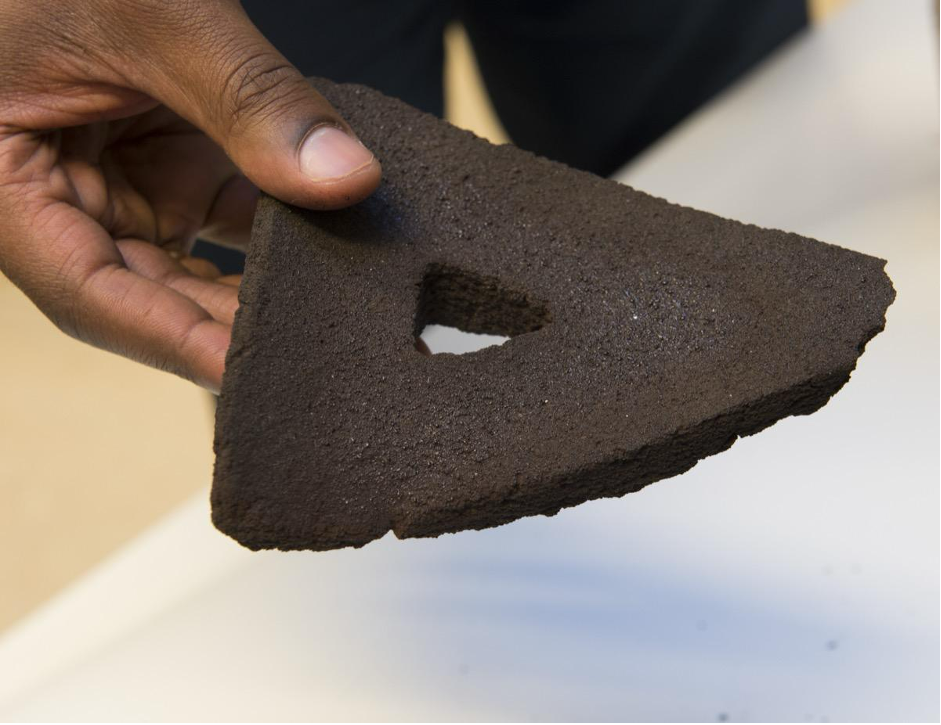
RegoLight Lunar Base © LIQUIFER
Building with and Living off Lunar Resources
by LIQUIFER
If you’d like to hear about the artwork,
please find the audioguide here.

Solar Sintered Sample, @ESA
Regolith—unconsolidated material like dust and rock fragments on the lunar surface—is a central focus of this exhibit. As a key resource for construction and life support on the Moon, regolith plays a vital role in LIQUIFER space architecture’s research and design philosophy. Through projects centered on in-situ resource utilization (ISRU), LIQUIFER explores how to use local materials to reduce dependence on Earth and support long-term human missions. For this exhibit, LIQUIFER presents a selection of these projects, namely RegoLight, LUWEX water on the moon, PAVER Paving the Road, and Fused Layer Deposition (FFLD). Alongside lunar regolith simulants the exhibit presents a model of a lunar habitat, material research, and visual representation into the engineering and architectural research for these projects.
Based on their project RegoLight, LIQUIFER presents their work on solar sintering of regolith into solid bricks for additive construction, as well as investigations into block shapes for building habitats, pathways, and landing pads. Material samples of the solar sintering technique with regolith simulant developed for this project are displayed next to a study of the research into the shapes of the building blocks that are envisioned to be used in automated construction of future lunar habitats. The dome-shaped forms of the habitat designs, part of what LIQUIFER calls the “new vernacular of outer space,” address constraints like volume, efficiency, and structural performance.
The project PAVER explored a different solar melting technique with regolith simulant to produce strong tiles for potential future infrastructure on the Moon, such as pathways to facilitate transport routes that are less dusty, and potential landing pads for spacecrafts. Material samples of this research are also exhibited. Additionally, research into material innovations such as fiber-reinforced regolith composites, 3D printing filaments made from regolith, present insights from the FFLD project.
Lastly, by the means of insights from the project LUWEX, water extraction from icy regolith—a critical resource for potable water, agriculture, shielding from radiation, and producing rocket fuel through hydrogen and oxygen separation—represents an approach to sustain life on the Moon by living off lunar resources.
About the space architects
LIQUIFER Vienna – Bremen is committed to collaborative work with international partners from a wide array of disciplines. A small interdisciplinary core team makes it possible that LIQUIFER plays a valuable role in the field of human space exploration. LIQUIFER’s work focuses on designing habitats and systems for space and extreme environments, often integrating biological principles into architecture.
Barbara Imhof is a Space Architect, design researcher, and Professor of Integrative Design with a focus on extreme environments at the Department of Experimental Architecture at the University of Innsbruck. She co-founded LIQUIFER with Susmita Mohanty in 2003 and has been also collaborating with international artists. For more than 20 years, she produced the podcast Space Specials, which explored the intersections of art, science, and space.
Waltraut Hoheneder holds diplomas in architecture and commercial sciences. She worked in market research and as design architect at Coop Himmelb(l)au. Since 2005 she co-manages LIQUIFER Systems Group Vienna holding a key role as senior designer. Her focus is on transformable structures and microbial systems in regenerative infrastructure for sustainable building. She taught architectural design at the University of Technology Vienna for 15 years.
René Waclavicek studied architecture at University of Technology Vienna and is a construction engineer with extensive experience in design and implementation. He joined LIQUIFER in 2005 and became a partner and co-managing director in 2019. His work spans interdisciplinary research, parametric design, and 3D printing technologies for the Moon and Mars. He has contributed to both terrestrial projects and the design and visualization of LIQUIFER’s portfolio.
Team members: Chris Gilbert, Peter Foth, Monika Brandić Lipińska, Ingo Retat, Daniel Schubert, Susmita Mohanty
Credits
Building with and Living off Lunar Resources
2025
by LIQUIFER
LIQUIFER (Waltraut Hoheneder, Barbara Imhof, René Waclavicek)
Miranda Fateri, professor at the faculty of mechanical engineering and material sciences at the University of Aalen, Germany
Jens Günster, professor at the Federal Institute for Materials Research and Testing, Berlin, Germany
Matthias Sperl, professor, Institute of Material Physics in Space, German Aerospace Center, Cologne
Paul Zabel, head of Synergetic Material Utilization research group, Germany Aerospace Center, Bremen.
Fused Fiber Layer Deposition (FFLD) of Lunar regolith, 2023 – 2026
University of Aalen, Germany
University of Aachen RWTH, Germany
LIQUIFER, Austria
The project has received funding from the European Space Agency under the Open Space Innovation Programme
LUWEX – Validation of Lunar Water Extraction and Purification Technologies for In-Situ Propellant and Consumables Production, 2022-2024
German Aerospace Center, Germany
Technische Universität Braunschweig, Germany
LIQUIFER, Austria
Thales Alenia Space, Italy
Wroclaw University for Science and Technology, Poland
Scanway sp. z o. o., Poland
The project has received funding from the European Union’s Horizon 2020 Research and Innovation Programme under Grant Agreement no 101081937.
PAVER – Paving the road for large area sintering of regolith, 2021-2024
Federal Institute for Materials Research and Testing, Berlin, Germany
University of Technology Clausthal, Germany
University of Aalen, Germany
LIQUIFER, Austria
The project has received funding from the European Space Agency under the Open Space Innovation Programme
RegoLight – Sintering Regolith with Solar Light, 2023 – 2026

